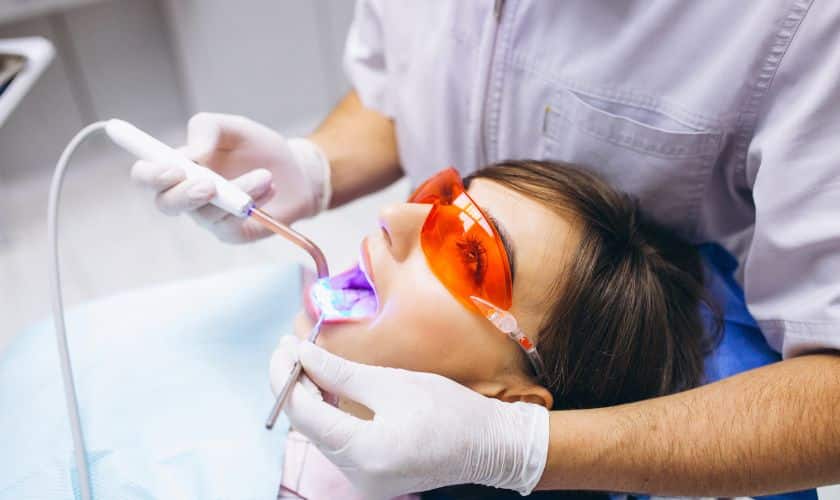When it comes to visiting the dentist, many people experience anxiety and fear due to the anticipation of pain and discomfort. However, thanks to advancements in technology, laser dentistry has revolutionized the field and made dental procedures more comfortable and efficient than ever before. With the use of lasers, dentists can now perform a wide range of treatments with minimal pain and impressive results. In this blog post, we will explore the world of laser dentistry, its benefits, and how it is transforming the dental experience.
What is Laser Dentistry?
Laser dentistry is an innovative field that harnesses the power of specialized dental lasers to perform a wide range of procedures with exceptional precision and minimal discomfort. These dental lasers emit highly-concentrated beams of light, which can be used to target specific areas in the mouth, including hard tissues like teeth and bone, as well as soft tissues like gums. By utilizing laser technology, dentists can achieve remarkable results while ensuring a more comfortable experience for patients.
In laser dentistry, different types of lasers are employed depending on the specific treatment required. Hard tissue lasers are used to address issues such as tooth decay and cavities. They enable dentists to precisely remove decayed tissues while preserving the healthy tooth structure. Furthermore, soft tissue lasers are effective for gum-related procedures. They can reshape gum tissue, treat gum disease, and even improve the appearance of gummy smiles. With the ability to selectively target and treat problem areas, laser dentistry offers a level of precision that traditional dental tools cannot match.
Benefits of Laser Dentistry
Not only does laser dentistry provide enhanced precision, but it also offers numerous benefits for patients. Due to the minimally invasive nature of laser procedures, they generally result in less pain and discomfort. The benefits of laser dentistry are:
1. Minimized Pain and Discomfort
One of the most significant advantages of laser dentistry is its ability to minimize pain and discomfort during dental procedures. Traditional dental tools like drills and scalpels can cause discomfort and may require anesthesia. Laser dentistry reduces the need for anesthesia in many cases, as the laser’s energy can often be sufficient for pain management.
2. Precise and Minimally Invasive
Laser technology allows dentists to precisely target the affected area while preserving the surrounding healthy tissues. This precision minimizes the need for cutting or stitching, resulting in quicker healing times and reduced post-operative complications.
3. Reduced Bleeding and Swelling
Laser dentistry helps to seal blood vessels and nerve endings as it operates, which leads to reduced bleeding and swelling during and after the procedure. Patients experience less discomfort and can recover faster without the typical side effects associated with traditional dental procedures.
4. Faster Healing
Since laser dentistry is minimally invasive and promotes clotting, patients often experience faster healing times. The laser’s sterilizing effect can also minimize the risk of infections, allowing for a smoother and quicker recovery period.
5. Improved Accuracy and Outcomes
Dental lasers offer dentists improved accuracy and control over the treatment process. They can precisely remove decay, reshape gums, and perform other procedures with enhanced precision, resulting in improved outcomes and aesthetic results.
Applications of Laser Dentistry
Laser dentistry has a wide range of applications, including:
1. Cavity Detection and Removal
Lasers can detect early signs of tooth decay that may not be visible to the naked eye, enabling dentists to treat cavities in their initial stages. They can also remove decayed tissues more precisely, leaving healthy tooth structures intact.
2. Gum Disease Treatment
Laser therapy can be used to remove infected gum tissue, treat gum disease, and encourage gum reattachment. Lasers can also reshape gum tissue to improve the appearance of gummy smiles.
3. Teeth Whitening
Dental lasers can enhance the effectiveness of teeth whitening procedures. The laser activates the whitening agents applied to the teeth, resulting in faster and more effective treatment.
4. Biopsy and Lesion Removal
Lasers are commonly used for biopsy procedures to remove small pieces of oral tissues for examination. They can also be used to remove lesions or growths in the mouth.
5. Dental Surgery
Lasers are increasingly used in various surgical procedures, such as gum contouring, frenectomies (removal of the frenulum), and crown lengthening.
Laser dentistry has ushered in a new era of dental care, offering patients painless procedures and delivering dazzling results. With its precise targeting and minimally invasive nature, laser technology has transformed the way dental treatments are performed. Patients can now experience reduced pain and discomfort, faster healing times, and improved outcomes. As technology continues to advance, the future of laser dentistry holds even greater potential, with researchers exploring new applications and further enhancing existing techniques. Whether it’s detecting cavities, treating gum disease, or enhancing the aesthetics of smiles, laser dentistry is reshaping the dental experience, paving the way for a brighter and more comfortable future in oral healthcare. Say goodbye to dental anxiety and hello to the remarkable world of laser dentistry.



